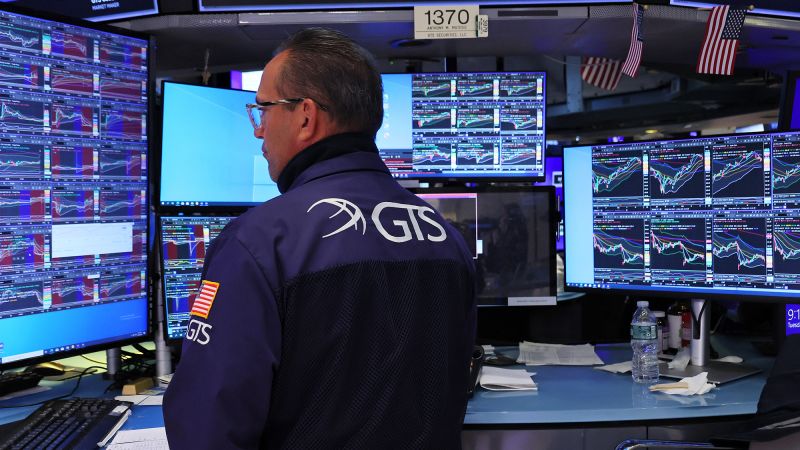On a tumultuous Friday in the financial markets, stocks experienced a notable drop following comments made by President Donald Trump regarding China’s adherence to their trade agreement with the United States. He claimed that China had “totally violated” the terms of the agreement, a statement that reverberated through Wall Street and contributed to the ongoing uncertainty surrounding trade relations between the two nations. The dire implications of Trump’s remarks marked another instance in a week filled with fluctuating tariff developments that have both bewildered and concerned investors.
As trading commenced on Friday, all major indices saw declines. The Dow Jones Industrial Average registered a slight dip, while the broader S&P 500 recorded a decrease of about 0.2%. The tech-centric Nasdaq Composite suffered a larger drop, falling by 0.4%. This situation underlines how sensitive the stock market is to geopolitical and economic news related to trade, reflecting the overarching investor anxiety over U.S.-China relations.
In his typical dramatic style, President Trump took to social media to express his views, asserting, “The bad news is that China, perhaps not surprisingly to some, HAS TOTALLY VIOLATED ITS AGREEMENT WITH US. So much for being Mr. NICE GUY!” This tweet encapsulated the president’s frustration but did not provoke as fierce a reaction from the markets as seen in previous instances. Industry insiders noted that Wall Street seems to have adopted a somewhat skeptical view regarding Trump’s threats, with market participants increasingly believing that he is likely to back down when it comes to imposing tariffs — a sentiment that has been humorously dubbed the ‘TACO’ trade, short for “Trump Always Chickens Out.”
The initiation of Trump’s remarks came at a time when the trade war had again captured the attention of investors and analysts alike. Earlier in the week, the stock market had rallied after the Court of International Trade temporarily blocked most of Trump’s tariffs on certain grounds, providing a glimmer of hope to investors. This optimism was quick to fade, however, as traders speculated that the administration would vigorously appeal the ruling and pursue alternative legal avenues, keeping the uncertainty surrounding tariffs alive.
Furthermore, on Thursday, a federal appeals court decided to pause the CIT’s ruling, which left Trump’s extensive tariff agenda in a precarious position pending further court evaluations. Greg Valiere, a chief U.S. policy strategist at AGF Investments, emphasized the complexity of the matter, stating, “The stunning, head-spinning, mind-boggling trade fiasco will not be resolved quickly,” implying that the issue might escalate further, possibly even reaching the Supreme Court.
As investors grappled with these developments, they were also met with fresh economic data suggesting that inflation, as measured by the Federal Reserve’s preferred gauge, had cooled in April more than economists had anticipated. However, this was countered by the revelation of a significant drop in consumer spending, creating a mixed economic signal for market participants.
Over the past week, Trump has reignited discussions regarding his trade war, resulting in renewed uncertainty in markets that had previously begun to calm down. The S&P 500 had shown signs of recovery from an early April slump caused by his inconsistent policies regarding “reciprocal” tariffs. Despite the recent fluctuations in the market, those investors who sold during the initial panic at the beginning of May have missed out on what is historically a robust month for equity markets. The benchmark index has been reported to rise over 6% in May, projecting itself towards its best monthly performance since 2023.
A notable trend observed was that, despite gains in the stock market since the lows experienced in April, a cloud of uncertainty still looms around tariff matters, especially given the evolving legal challenges surrounding the administration’s strategies. Clark Bellin, the president and CIO at Bellwether Wealth, reiterated this sentiment, reflecting on the ongoing apprehensions in Wall Street circles.
In the currency market, the U.S. dollar managed to gain value, with the dollar index showing trends toward ending the month in the green. A potential reversal from a four-month losing streak was also under discussion, illustrating how volatile economic indicators can impact currency valuation.
Looking forward, analysts predict that market volatility will persist as investors navigate through a myriad of both economic and geopolitical risks. The consensus indicates an ongoing cautious approach to investment as the S&P 500 seeks to maintain its upward trajectory, currently up approximately 0.5% for the year. In light of this fast-evolving situation, stakeholders are eager for updates as the story continues to develop.



